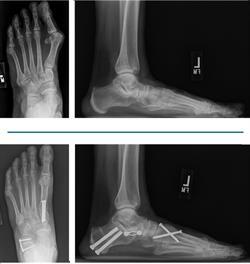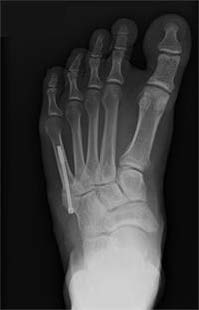Foot Fractures
There are 26 bones in each of your feet, all of which can break. There are several different types of fractures:
- Non-displaced: The bone breaks but stays in place
- Displaced: The bone breaks into two pieces that move apart from one another
- Comminuted: The bone is broken in multiple places
- Open fracture: The bone breaks through the skin after fracturing
If you injure your foot, your foot and ankle orthopedic surgeon will take X-rays to see if you have a broken bone. X-rays will identify most fractures but some smaller and more subtle fractures may require CT or MRI scans. Not all fractures require surgery, and your surgeon will help determine how your fracture should be treated.
If you need surgery for your foot fracture, the goals are to restore the fractured bone to its correct position, stabilize the bone in this position, encourage healing, restore function, and reduce the risk of future problems such as persistent pain, loss of motion, and arthritis.
Diagnosis
All foot fractures are different, but generally speaking if a fracture is significantly displaced it is likely to benefit from surgery. This is especially true if a fracture enters a joint and the joint surface is disrupted and displaced. Restoring the alignment and stabilizing the fracture in its correct position will decrease the risk of future problems, such as pain, swelling, deformity, and arthritis.
In some cases, surgery may be appropriate for non-displaced or minimally displaced fractures if the broken bones are likely to be unstable. In such cases surgery can maintain the alignment and encourage healing in the right position.
Even some non-displaced and stable fractures may benefit from surgery. One such fracture, called a Jones fracture, often is treated surgically in active and athletic individuals because it is likely to get them back to their activities more quickly than non-surgical treatment.
When the risks of surgery outweigh potential benefits, your foot and ankle orthopedic surgeon may recommend non-surgical treatment. This decision is based on an understanding of your entire body and pre-existing conditions. For example, if you have a history of heart problems, your surgeon may recommend non-surgical treatment or that you see your cardiologist to determine if surgery is safe before proceeding.
Treatment
Foot fracture surgery involves making an incision in the skin centered over the fractured bone. The bone is then exposed so the orthopedic surgeon can see the fracture. The fractured bone fragments are realigned as well as possible and secured with implants such as pins, wires, screws, and plates. After stabilizing the fracture your surgeon will stitch the incision closed, apply a sterile bandage, and place your foot in a cast, splint, boot, or post-operative shoe.
With some fractures, the surgeon can restore the alignment of the fractured bone without a large incision. In this method, the fracture is fixed with appropriate implants through one or more small incisions. This is called a percutaneous fracture fixation. The advantages of this technique include smaller incisions, less trauma to the tissues, less disruption of the blood supply to the bone, and less pain after surgery.
Recovery
After surgery your foot and ankle orthopedic surgeon will place your foot into a cast, splint, boot, or post-op shoe. It is important to keep your foot elevated as much as possible to reduce pain and swelling. In most cases your doctor also will want you to stay off your foot completely for 1-3 months, depending on the injury.
A few weeks after surgery your surgeon will check the wound and remove the stitches. Your surgeon may have you begin working on range-of-motion exercises of the ankle, foot, and toes. They may also refer you to a physical therapist.
Your doctor will see you at regular intervals and check X-rays to see how well the fracture is healing. Based on your fracture type and this evaluation, your surgeon will decide when you can begin to bear weight on the injured foot. They may have you begin weightbearing with a special boot and allow you to advance slowly to your normal footwear as symptoms allow. In most cases you can expect 3-6 months or more before you return to full activity without restrictions, and up to a year before you reach maximum improvement.
Risks and Complications
All surgeries come with possible complications, including the risks associated with anesthesia, infection, damage to nerves and blood vessels, and bleeding or blood clots. To minimize the risk for blood clots, you may be placed on aspirin or a blood thinning medication for several weeks after surgery. Unfortunately, even when on these medications, blood clots can occur post-operatively.
Potential complications of foot fracture surgery include wound breakdown, failure of the fracture to heal (nonunion), fracture healing in a bad position (malunion), loss of fracture alignment prior to healing, implant failure, persistent pain, loss of motion, and arthritis. Smoking is a significant risk factor for multiple complications. If you are a smoker, your surgeon will discuss this with you before operating.
Foot and ankle orthopedic surgeons are uniquely qualified to identify and treat fractures of the foot and should be your first resource when you experience a foot injury.



